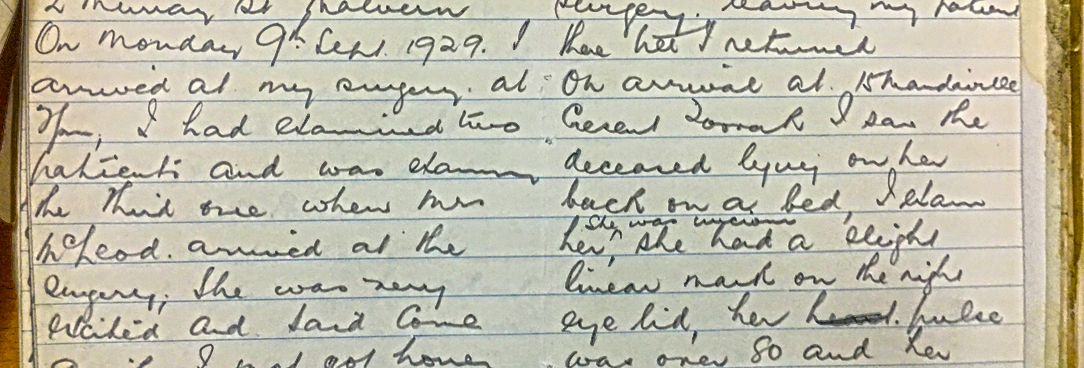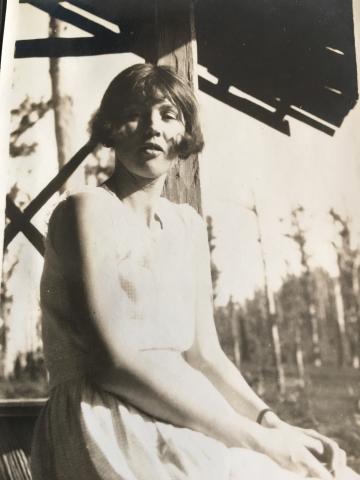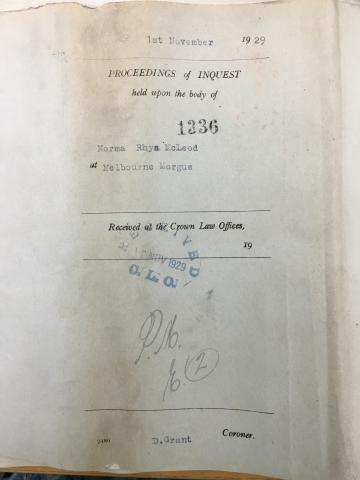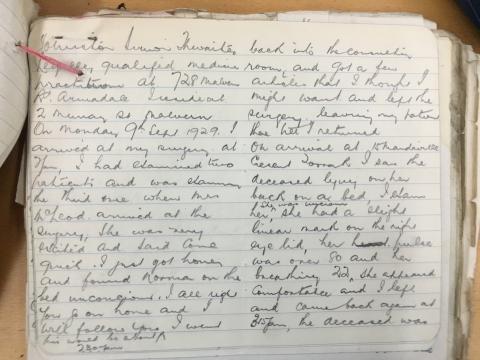
Author: Tara Oldfield
Senior Communications Advisor
Writer and host of the Murder Archives podcast, Emma Curtin’s journey into talking and writing about true crime was accidental.
“As well as being an academic editor, I’m a historian and while I was doing some local research I came across a newspaper article about Norma McLeod’s death in 1929: ‘Found on bed with garment over head. Extensive wounds’. It immediately intrigued me but I had no idea how all-consuming the story would become.”
Inquests
Emma says her starting point for the research was Public Record Office Victoria where she found Norma’s inquest record, dated 1 November 1929. Inquests generally contain the Coroner’s verdict on a death, names of jurors, depositions of evidence, Victoria Police reports and other exhibits sometimes including – often confronting – photographs of crime scenes and the dead. Most of the inquests in PROV’s collection have been indexed so you just need to know the name and date of the deceased person. Going in, Emma had no idea what the inquest for Norma would contain. In her recent book Fractured Silence: The Mysterious Death of Norma Rhys McLeod, 1929 she writes:
“The inquest file arrived in a thick, see-through plastic zip-lock bag. The bundle wasn’t large, not what I’d expected, but it was a thrill to open the neatly-folded, slightly faded documents, apparently untouched for decades. The distinctive smell of old paper hit me as I turned the pages and dust brushed off on my fingers. It was a sensory delight; a researcher’s idea of bliss. The inquest documents consisted of two large drawings – one a plan of the McLeods’ house; the other a drawn outline of the local area, to be exhibited at the inquest in relation to one of the police theories. Also in the package of documents were the original police report of Norma’s death, the pathology report, witness statements, a list of exhibits and the coroner’s verdict.”
The inquest outlined the evidence around what happened to Norma on the fateful day of Monday 9 September 1929. Norma was just 29 years old when she was found unconscious at her Toorak home with a pair of men’s underwear strewn across her forehead. She died from her injuries without ever being able to reveal her attacker. The post-mortem document in the inquest file revealed her death was caused by a skull fracture from a violent blow. What the inquest didn’t reveal? Her killer.
Emma’s continued research into the case spawned the book and the Murder Archives podcast released earlier this year. Episodes cover Norma’s life and last day as well as initial police and public theories and suspects.
Police correspondence
Emma said another series of records that proved to be invaluable to her projects were Police Correspondence files. These records cover a range of correspondence of police matters including training, land use, watch house reports, as well as some criminal investigations – particularly missing persons and unsolved burglaries and murders.
“When I started looking through the Public Record Office database, I discovered there were 44 archived boxes of police correspondence for 1929 alone… Days of trawling through mountains of ageing paper followed. My hands were dry from handling the dusty paper and my interest started to fade. Did the police files on Norma’s case really exist? Was I just wasting my time? Maybe, but I couldn’t stop … I kept thinking, just one more box and then I’d stop. One more box … and then … one more … THE box.”
As so many researchers will concur, nothing beats the feeling of finally hitting pay dirt!
Within the correspondence files, Emma found a bundle tied in pink string with Norma’s name on the front. The bundle held within it official police reports, witness statements, outlines of proposed questions compiled for the inquest and letters from the public about the case offering their own theories in desperate attempts to help police.
“I had my hands on the police reports and thirty letters or notes from the public delivered to the Criminal Investigation Branch between 10 September and 29 October 1929. Some of these would ultimately prove so pivotal to the case,” Emma writes in her book.
Researching crime in the archives
Start your own crime research by visiting our Justice, Crime and Law topic page. In addition to the inquests and police correspondence, other fascinating series include the Criminal Trial Briefs and Registers of Male and Female Prisoners.
The records mentioned here are:
• Inquest file for Norma Rhys McLeod, dated 1 November 1929: VPRS 24/P0 Inquest Deposition Files, unit 1163, item 1929/1136.
• Police Correspondence File: VPRS 807/P0 Inward Correspondence Files, unit 831, item 1929.
Listen to Murder Archives online here: murderarchives.com.au or via your favourite podcast app.
Emma’s book Fractured Silence: The Mysterious Death of Norma Rhys McLeod, 1929 is out now and available on Amazon.
Material in the Public Record Office Victoria archival collection contains words and descriptions that reflect attitudes and government policies at different times which may be insensitive and upsetting
Aboriginal and Torres Strait Islander Peoples should be aware the collection and website may contain images, voices and names of deceased persons.
PROV provides advice to researchers wishing to access, publish or re-use records about Aboriginal Peoples



